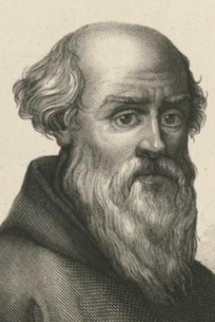|
Guido d'Arezzo
|
|||||||||||||||
|
|
|||||||||||||||
|
Guido d'Arezzo (ca. 995-ca. 1050) was an Italian monk. He studied at the Benedictine Abbey of Pomposa and then taught singing there. The bishop of Arezzo invited him to teach music at his cathedral school and became a great admirer of Guido's new teaching devices. He was the music theorist and teacher who developed the hexachord system and the musical staff. In simplest terms, a hexachord is a set of six notes arranged to form intervals of two whole-tones, a central semitone, and two more whole-tones. We represent this as T-T-S-T-T, where T = whole-tone & S = a semitone. In Guido's system, the six notes of a hexachord were given the syllables ut-re-mi-fa-sol-la, with the semitone always occurring between the syllables mi-fa. At Pomposa, Guido had developed a new way of writing Gregorian chant, adopting a four-line staff and clefs. |
|||||||||||||||
 |
|||||||||||||||
|
Guido d'Arezzo
|
|||||||||||||||